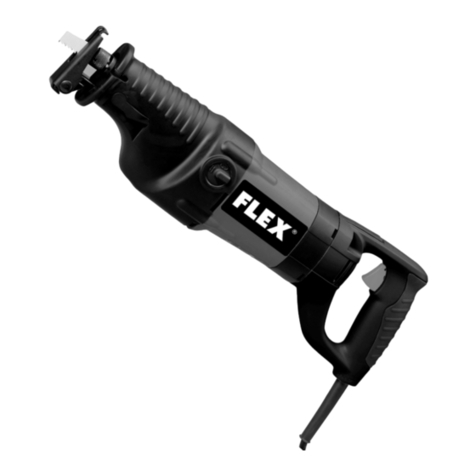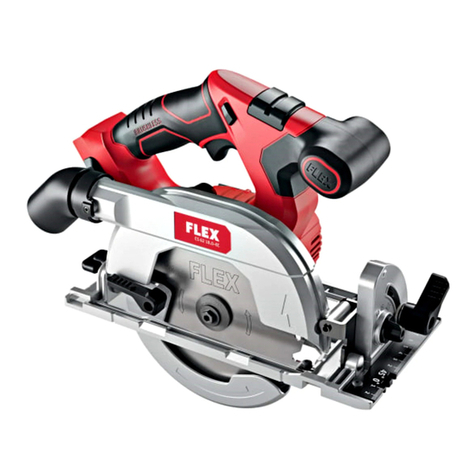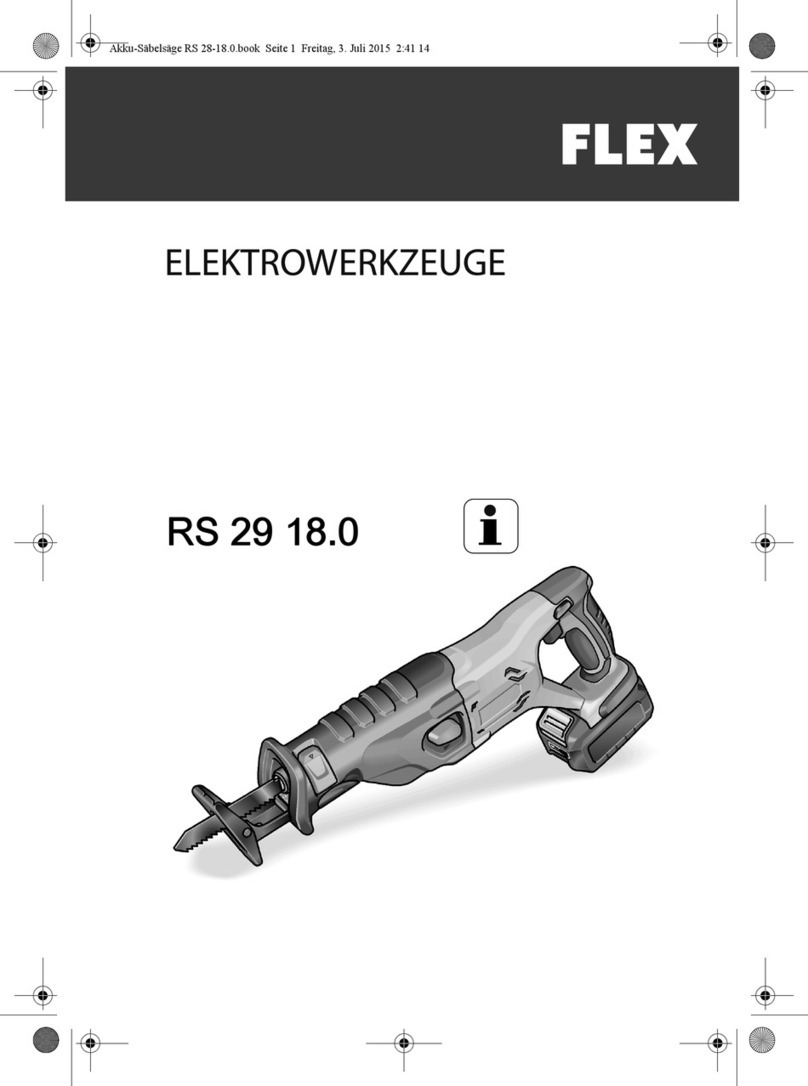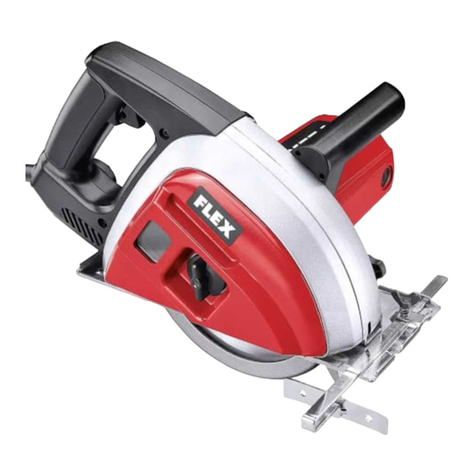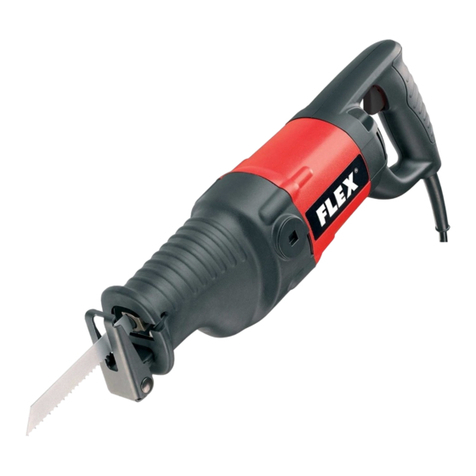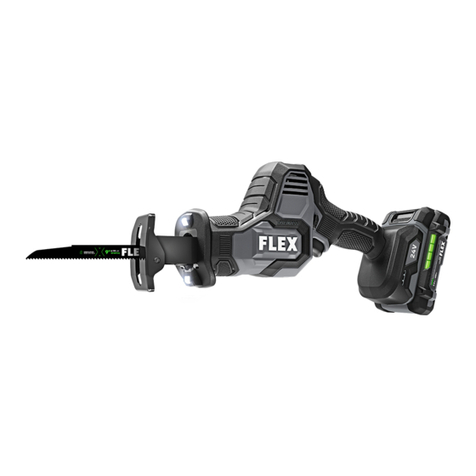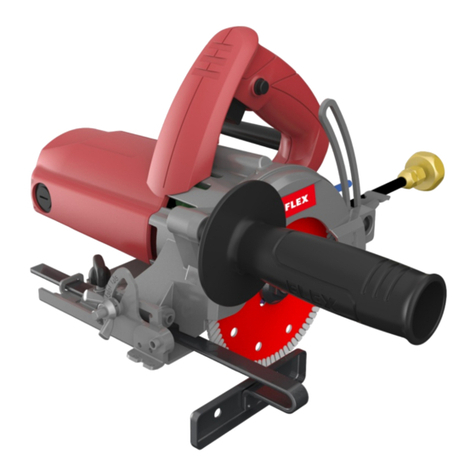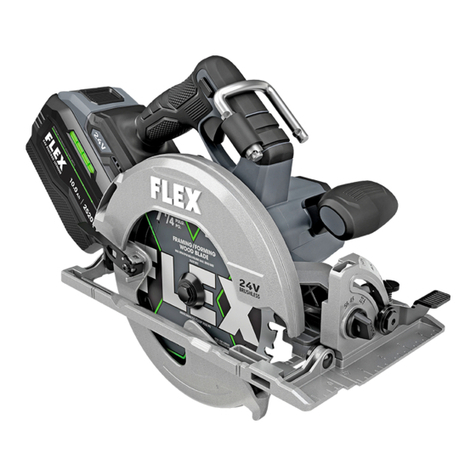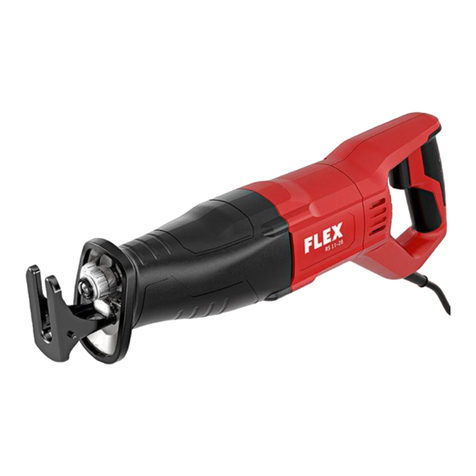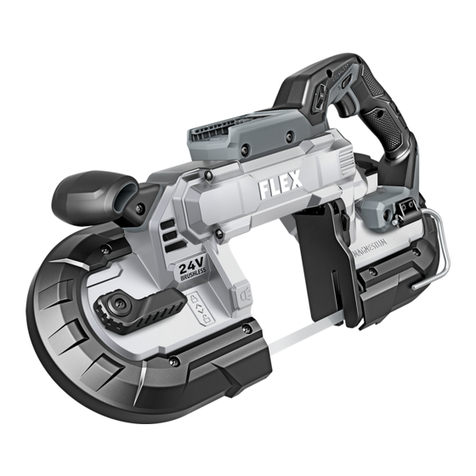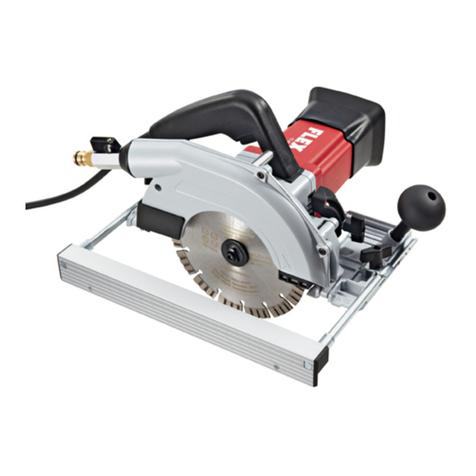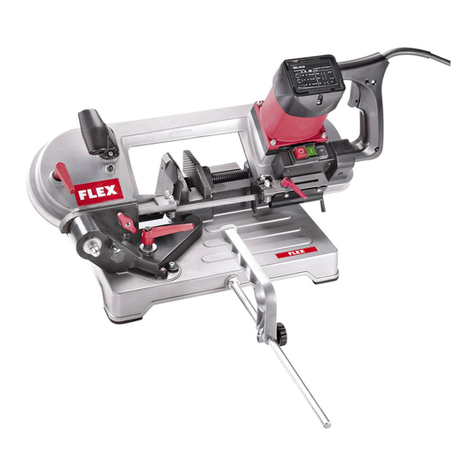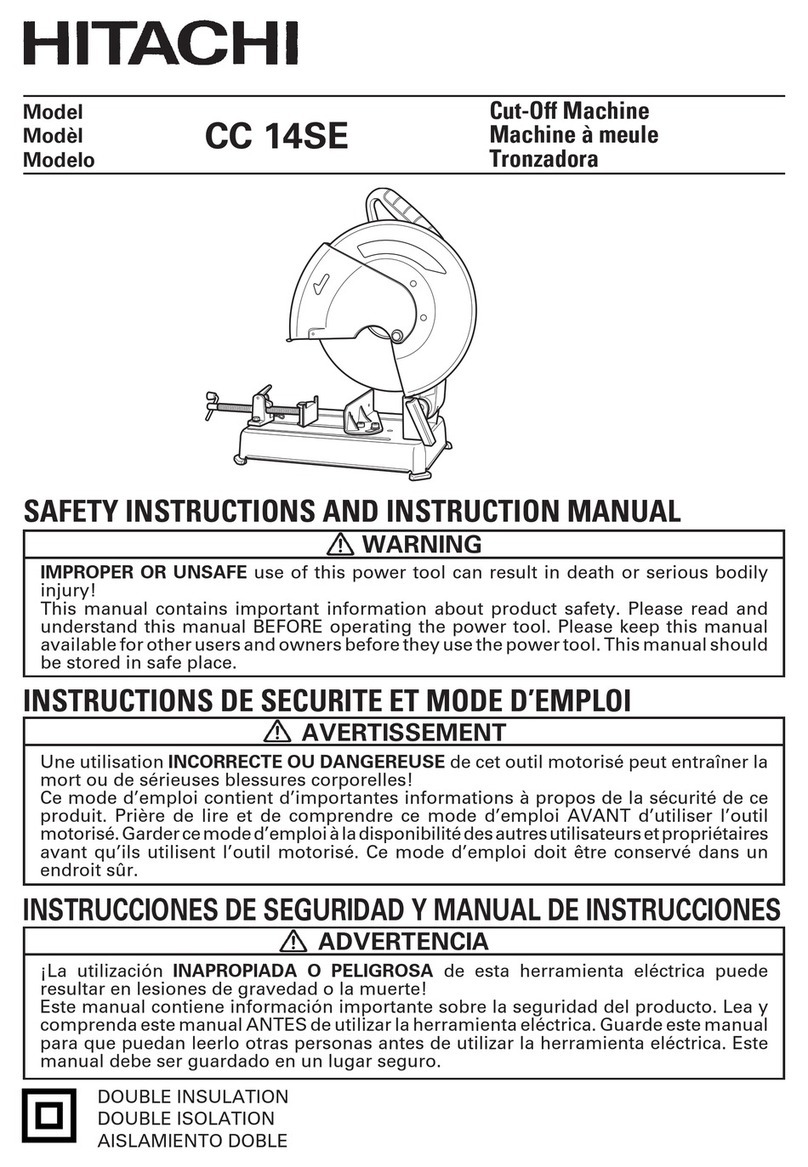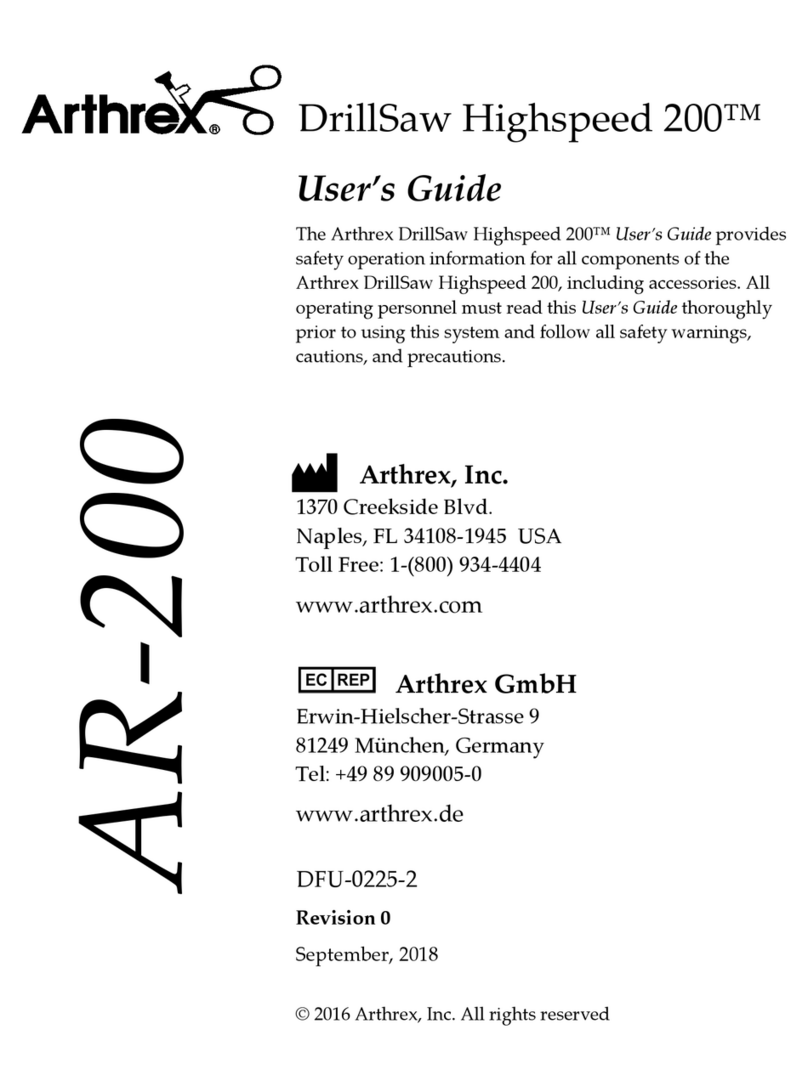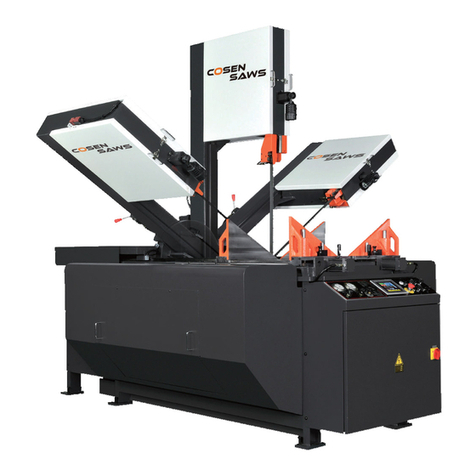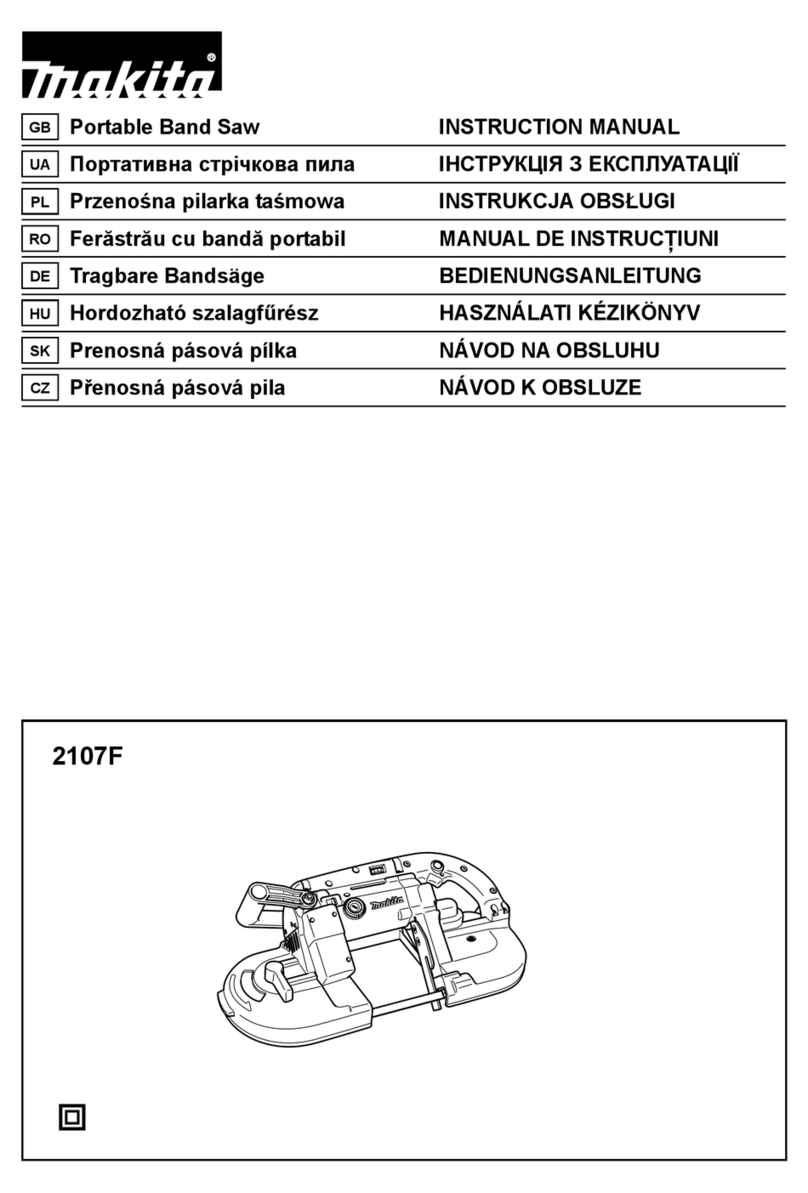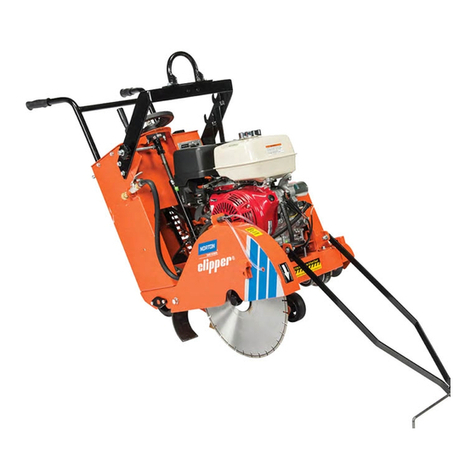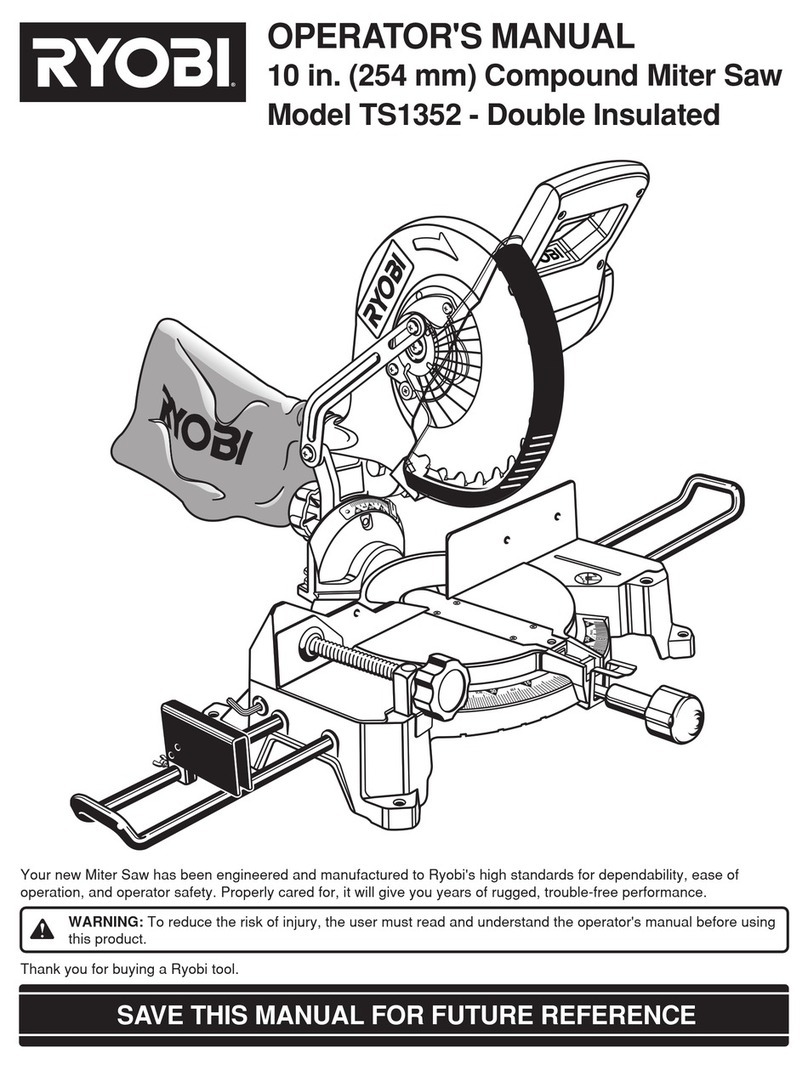Flex FX7141A User manual

Model:
Modèle:
Modelo:
OPERATOR’S MANUAL
MANUEL DE L’UTILISATEUR
MANUAL DEL OPERADOR
833-FLEX-496
(833-3539-496)
For English
Version
See page 2
◆
Version
française
Voir page 46
◆
Versión en
español
Ver la página 97
www.Registermyex.com
Contact Us /
Nous contacter /
Contáctenos
24V 12" DUAL BEVEL SLIDING COMPOUND MITER SAW
SCIE À ONGLET COMPOSÉ COULISSANTE À BISEAU DOUBLE DE
12 PO, 24 V
SIERRA INGLETADORA COMPUESTA DESLIZANTE DE DOBLE BISEL
DE 12 PULGADAS DE 24 V
FX7141A

-2-
SAFETY SYMBOLS
The purpose of safety symbols is to attract your attention to possible dangers. The safety symbols
and the explanations with them deserve your careful attention and understanding. The symbol
warnings do not, by themselves, eliminate any danger. The instructions and warnings they give are
no substitutes for proper accident prevention measures.
WARNING Be sure to read and understand all safety instructions in this Operator’s Manual,
including all safety alert symbols such as “DANGER,” “WARNING,” and
“CAUTION” before using this tool. Failure to follow all instructions listed below may result in
electric shock, re, and/or serious personal injury.
The denitions below describe the level of severity for each signal word. Please read the manual and
pay attention to these symbols.
This is the safety alert symbol. It is used to alert you to potential personal
injury hazards. Obey all safety messages that follow this symbol to avoid
possible injury or death.
DANGER DANGER indicates a hazardous situation which, if not avoided, will result in
death or serious injury.
WARNING WARNING indicates a hazardous situation which, if not avoided, could result
in death or serious injury.
CAUTION CAUTION, used with the safety alert symbol, indicates a hazardous situation
which, if not avoided, will result in minor or moderate injury.
Damage Prevention and Information Messages
These inform the user of important information and/or instructions that could lead to equipment or
other property damage if they are not followed. Each message is preceded by the word “NOTICE”,
as in the example below:
NOTICE: Equipment and/or property damage may result if these instructions are not followed.
WARNING The operation of any power tools can result in foreign
objects being thrown into your eyes, which can result in
severe eye damage. Before beginning power tool operation, always wear
safety goggles or safety glasses with side shields and a full face shield when
needed. We recommend a Wide Vision Safety Mask for use over eyeglasses
or standard safety glasses with side shields. Always use eye protection
which is marked to comply with ANSI Z87.1.

-3-
IMPORTANT SAFETY WARNINGS
WARNING Read all safety warnings, instructions, illustrations and specications
provided with this power tool. Failure to follow all instructions listed below
may result in electric shock, re and/or serious injury.
SAVE ALL WARNINGS AND INSTRUCTIONS FOR FUTURE REFERENCE.
The term “power tool” in the warnings refers to your mains-operated (corded) power tool or
battery-operated (cordless) power tool.
Work area safety
Keep work area clean and well lit. Cluttered
or dark areas invite accidents.
Do not operate power tools in explosive
atmospheres, such as in the presence of
ammable liquids, gases or dust. Power
tools create sparks which may ignite the dust
or fumes.
Keep children and bystanders away while
operating a power tool. Distractions can
cause you to lose control.
Electrical safety
Power tool plugs must match the outlet.
Never modify the plug in any way. Do not use
any adapter plugs with earthed (grounded)
power tools. Unmodied plugs and matching
outlets will reduce risk of electric shock.
Avoid body contact with earthed or
grounded surfaces, such as pipes, radiators,
ranges and refrigerators. There is an
increased risk of electric shock if your body is
earthed or grounded.
Do not expose power tools to rain or wet
conditions. Water entering a power tool will
increase the risk of electric shock.
Do not abuse the cord. Never use the cord
for carrying, pulling or unplugging the
power tool. Keep cord away from heat, oil,
sharp edges or moving parts. Damaged or
entangled cords increase the risk of electric
shock.
When operating a power tool outdoors, use
an extension cord suitable for outdoor use.
Use of a cord suitable for outdoor use reduces
the risk of electric shock.
If operating a power tool in a damp location
is unavoidable, use a ground fault circuit
interrupter (GFCI) protected supply. Use of a
GFCI reduces the risk of electric shock.
Personal safety
Stay alert, watch what you are doing and
use common sense when operating a power
tool. Do not use a power tool while you are
tired or under the inuence of drugs, alcohol
or medication. A moment of inattention while
operating power tools may result in serious
personal injury.
Use personal protective equipment. Always
wear eye protection. Protective equipment
such as a dust mask, non-skid safety shoes,
hard hat or hearing protection used for
appropriate conditions will reduce personal
injuries.
Prevent unintentional starting. Ensure
the switch is in the o-position before
connecting to power source and/or battery
pack, picking up or carrying the tool.
Carrying power tools with your nger on the
switch or energizing power tools that have the
switch on invites accidents.
Remove any adjusting key or wrench before
turning the power tool on. A wrench or a key
left attached to a rotating part of the power tool
may result in personal injury.
Do not overreach. Keep proper footing
and balance at all times. This enables better
control of the power tool in unexpected
situations.
Dress properly. Do not wear loose clothing
or jewelry. Keep your hair, and clothing away
from moving parts. Loose clothes, jewelry or
long hair can be caught in moving parts.
If devices are provided for the connection
of dust extraction and collection facilities,
ensure these are connected and properly
used. Use of dust collection can reduce dust-
related hazards.

-4-
Do not let familiarity gained from frequent
use of tools allow you to become
complacent and ignore tool safety
principles. A careless action can cause severe
injury within a fraction of a second.
Power tool use and care
Do not force the power tool. Use the correct
power tool for your application. The correct
power tool will do the job better and safer at
the rate for which it was designed.
Do not use the power tool if the switch
does not turn it on and o. Any power tool
that cannot be controlled with the switch is
dangerous and must be repaired.
Disconnect the plug from the power
source and/or remove the battery pack,
if detachable, from the power tool before
making any adjustments, changing
accessories, or storing power tools. Such
preventive safety measures reduce the risk of
starting the power tool accidentally.
Store idle power tools out of the reach of
children and do not allow persons unfamiliar
with the power tool or these instructions
to operate the power tool. Power tools are
dangerous in the hands of untrained users.
Maintain power tools and accessories.
Check for misalignment or binding of
moving parts, breakage of parts and any
other condition that may aect the power
tool’s operation. If damaged, have the power
tool repaired before use. Many accidents are
caused by poorly maintained power tools.
Keep cutting tools sharp and clean. Properly
maintained cutting tools with sharp cutting
edges are less likely to bind and are easier to
control.
Use the power tool, accessories and
tool bits etc. in accordance with these
instructions, taking into account the working
conditions and the work to be performed.
Use of the power tool for operations dierent
from those intended could result in a hazardous
situation.
Keep handles and grasping surfaces dry,
clean and free from oil and grease. Slippery
handles and grasping surfaces do not allow
for safe handling and control of the tool in
unexpected situations.
Battery tool use and care
Recharge only with the charger specied by
the manufacturer. A charger that is suitable for
one type of battery pack may create a risk of
re when used with another battery pack.
Use power tools only with specically
designated battery packs. Use of any other
battery packs may create a risk of injury and
re.
When battery pack is not in use, keep it
away from other metal objects, like paper
clips, coins, keys, nails, screws or other
small metal objects, that can make a
connection from one terminal to another.
Shorting the battery terminals together may
cause burns or a re.
Under abusive conditions, liquid may be
ejected from the battery; avoid contact.
If contact accidentally occurs, ush with
water. If liquid contacts eyes, additionally
seek medical help. Liquid ejected from the
battery may cause irritation or burns.
Do not use a battery pack or tool that is
damaged or modied. Damaged or modied
batteries may exhibit unpredictable behavior
resulting in re, explosion or risk of injury.
Do not expose a battery pack or tool to re
or excessive temperature. Exposure to re or
temperature above 265 °F (130 °C) may cause
explosion.
Follow all charging instructions and do not
charge the battery pack or tool outside
the temperature range specied in the
instructions. Charging improperly or at
temperatures outside the specied range may
damage the battery and increase the risk of re.
Service
Have your power tool serviced by a
qualied repair person using only identical
replacement parts. This will ensure that the
safety of the power tool is maintained.
Never service damaged battery packs.
Service of battery packs should only be
performed by the manufacturer or authorized
service providers.

-5-
SAFETY WARNINGS FOR MITER SAW
• Miter saws are intended to cut wood or
wood-like products, they cannot be used
with abrasive cut-o wheels for cutting
ferrous material such as bars, rods, studs,
etc. Abrasive dust causes moving parts
such as the lower guard to jam. Sparks from
abrasive cutting will burn the lower guard, the
kerf insert and other plastic parts.
• Use clamps to support the workpiece
whenever possible. If supporting the
workpiece by hand, you must always keep
your hand at least 100 mm (4”) from either
side of the saw blade. Do not use this
saw to cut pieces that are too small to be
securely clamped or held by hand. If your
hand is placed too close to the saw blade,
there is an increased risk of injury from blade
contact.
• The workpiece must be stationary and
clamped or held against both the fence
and the table. Do not feed the workpiece
into the blade or cut “freehand” in any way.
Unrestrained or moving workpieces could be
thrown at high speeds, causing injury.
• Push the saw through the workpiece. Do
not pull the saw through the workpiece.
To make a cut, raise the saw head and pull
it out over the workpiece without cutting,
start the motor, press the saw head down
and push the saw through the workpiece.
Cutting on the pull stroke is likely to cause the
saw blade to climb on top of the workpiece
and violently throw the blade assembly
towards the operator.
• Never cross your hand over the intended
line of cutting either in front or behind the
saw blade. Supporting the workpiece “cross
handed” i.e. holding the workpiece to the right
of the saw blade with your left hand or vice
versa is very dangerous.
• Do not reach behind the fence with either
hand closer than 100 mm (4”) from either
side of the saw blade, to remove wood
scraps, or for any other reason while the
blade is spinning. The proximity of the
spinning saw blade to your hand may not be
obvious and you may be seriously injured.
• Inspect your workpiece before cutting. If
the workpiece is bowed or warped, clamp
it with the outside bowed face toward the
fence. Always make certain that there
is no gap between the workpiece, fence
and table along the line of the cut. Bent
or warped workpieces can twist or shift and
may cause binding on the spinning saw blade
while cutting. There should be no nails or
foreign objects in the workpiece.
• Do not use the saw until the table is clear
of all tools, wood scraps, etc., except
for the workpiece. Small debris or loose
pieces of wood or other objects that contact
the revolving blade can be thrown with high
speed.
• Cut only one workpiece at a time. Stacked
multiple workpieces cannot be adequately
clamped or braced and may bind on the blade
or shift during cutting.
• Ensure the miter saw is mounted or placed
on a level, rm work surface before use. A
level and rm work surface reduces the risk of
the miter saw becoming unstable.
• Plan your work. Every time you change the
bevel or miter angle setting, make sure the
adjustable fence is set correctly to support
the workpiece and will not interfere with
the blade or the guarding system. Without
turning the tool “ON” and with no workpiece
on the table, move the saw blade through a
complete simulated cut to assure there will be
no interference or danger of cutting the fence.
• Provide adequate support such as
table extensions, saw horses, etc. for a
workpiece that is wider or longer than the
table top. Workpieces longer or wider than
the miter saw table can tip if not securely
supported. If the cut-o piece or workpiece
tips, it can lift the lower guard or be thrown by
the spinning blade.
• Do not use another person as a substitute
for a table extension or as additional
support. Unstable support for the workpiece
can cause the blade to bind or the workpiece
to shift during the cutting operation pulling
you and the helper into the spinning blade.
• The cut-o piece must not be jammed or
pressed by any means against the spinning
saw blade. If conned, i.e. using length stops,
the cut-o piece could get wedged against
the blade and thrown violently.

-6-
• Always use a clamp or a xture designed
to properly support round material such as
rods or tubing. Rods have a tendency to roll
while being cut, causing the blade to “bite”
and pull the work with your hand into the
blade.
• Let the blade reach full speed before
contacting the workpiece. This will reduce
the risk of the workpiece being thrown.
• If the workpiece or blade becomes
jammed, turn the miter saw o. Wait for all
moving parts to stop and disconnect the
plug from the power source and/or remove
the battery pack. Then work to free the
jammed material. Continued sawing with
a jammed workpiece could cause loss of
control or damage to the miter saw.
• After nishing the cut, release the switch,
hold the saw head down and wait for the
blade to stop before removing the
cut-o piece. Reaching with your hand near
the coasting blade is dangerous.
• Hold the handle rmly when making an
incomplete cut or when releasing the switch
before the saw head is completely in the
down position. The braking action of the saw
may cause the saw head to be suddenly pulled
downward, causing a risk of injury.
• Wear eye protection!
• Keep hands and body out of the path of the
saw blade. Contact with blade will result in
serious injury.
• Check guarding system to make sure it is
functioning correctly.
• Never reach around saw blade.
• Turn o the saw and wait for saw blade to
stop before moving workpiece or changing
settings.
ADDITIONAL SAFETY RULES
• Develop a periodic maintenance schedule
for your tool. When cleaning a tool be
careful not to disassemble any portion
of the tool since internal wires may be
misplaced or pinched or safety guard
return springs may be improperly mounted.
Certain cleaning agents such as gasoline,
carbon tetrachloride, ammonia, etc. may
damage plastic parts.
• Do not use the miter saw to cut ber
cement board. Cutting materials containing
crystalline silica may create exposures to
respirable silica dust.
• Before each use, review all warnings
located on the miter saw.
• Use this miter saw only as intended.
Unintended use may result in personal injury
and property damage.
• Risk of electric shock. Do not use in the rain.
• To reduce the risk of electrical shock, do not
put the miter saw in water or other liquid. Do
not place or store the miter saw where it can
fall or be pulled into a tub or sink.
• Avoid overheating the blade tips and avoid
melting plastic materials during cutting.
DANGER People with electronic de-
vices, such as pacemakers,
should consult their physician(s) before using
this product. Operation of electrical equipment
in close proximity to a heart pacemaker could
cause interference or failure of the pacemaker.
WARNING
Drilling, sawing, sanding or machining wood
products can expose you to wood dust, a
substance known to the State of California to
cause cancer. Avoid inhaling wood dust or use
a dust mask or other safeguards for personal
protection. For more information go to
www.P65Warnings.ca.gov/wood.
Some dust created by power sanding, sawing,
grinding, drilling and other construction
activities contains chemicals known to the
State of California to cause cancer, birth
defects or other reproductive harm. Some
examples of these chemicals are:
– Lead from lead-based paints.
– Crystalline silica from bricks, cement, and
other masonry products.
– Arsenic and chromium from chemically-
treated lumber.

-7-
Your risk from these exposures varies,
depending upon how often you do this type
of work. To reduce your exposure to these
chemicals:
– Work in a well-ventilated area.
– Work with approved safety equipment, such
as dust masks that are specially designed to
lter out microscopic particles.
– Avoid prolonged contact with dust from
power sanding, sawing, grinding, drilling, and
other construction activities. Wear protective
clothing and wash exposed areas with soap
and water. Allowing dust to get into your
mouth or eyes or to lie on the skin may
promote absorption of harmful chemicals.
FCC CAUTION
1. This device complies with Part 15 of the FCC
Rules. Operation is subject to the following
two conditions:
(1) This device may not cause harmful
interference.
(2) This device must accept any interference
received, including interference that may
cause undesired operation.
2. Changes or modications not expressly
approved by the party responsible for
compliance could void the user’s authority to
operate the equipment.
NOTICE: This equipment has been tested
and found to comply with the limits for a
Class B digital device, pursuant to Part 15 of
the FCC Rules. These limits are designed to
provide reasonable protection against harmful
interference in a residential installation.
This equipment generates, uses, and can
radiate radio frequency energy and, if not
installed and used in accordance with the
instructions, may cause harmful interference
to radio communications. However, there is
no guarantee that interference will not occur
in a particular installation. If this equipment
does cause harmful interference to radio or
television reception, which can be determined
by turning the equipment o and on, the user is
encouraged to try to correct the interference by
one or more of the following measures:
• Reorient or relocate the receiving antenna.
• Increase the separation between the
equipment and receiver.
• Connect the equipment into an outlet on a
circuit dierent from that to which the receiver
is connected.
• Consult the dealer or an experienced radio/TV
technician for help.
ELECTRICAL REQUIREMENTS
Electric brake
Your saw is equipped with an automatic electric
brake which is designed to stop the blade
from spinning in about ve (5) seconds after
you release the trigger switch. It is useful when
making certain cuts in wood where a coasting
blade would result in a wide, imprecise cut.
WARNING When electrical power is
lost due to blown fuse or
other causes, the motor will gradually slow
down and the braking action is initiated
ONLY by the release of the trigger switch.
The electric blade brake of your miter saw
has been designed for highest degree of
reliability, but unexpected circumstances
such as contamination on the commutator
and brushes,failure of motor’s components
or overheating can cause the brake not to
activate. If this condition occurs, turn the saw
“ON” and “OFF” four to ve times without
contacting the workpiece. If the tool operates
but the brake does not consistently stop
the blade in about ve seconds, DO NOT
use saw and have it serviced immediately.
WARNING The brake action of this
saw is not intended as a
safety feature. Remember to let the saw
blade come to a complete stop before
raising the blade from the workpiece. As
always, the guard system is your best
protection against unintentional contact with
a spinning saw blade. NEVER wedge open or
defeat the closing action of the lower guard.

-8-
SYMBOLS
IMPORTANT: Some of the following symbols may be used on your tool. Please study them and
learn their meaning. Proper interpretation of these symbols will allow you to operate the tool better
and safer.
Symbol Name Designation/Explanation
V Volts Voltage
A Amperes Current
Hz Hertz Frequency (cycles per second)
W Watt Power
kg Kilograms Weight
min Minutes Time
s Seconds Time
Wh Watt-hours Battery capacity
Ah Ampere-hours Battery capacity
ø Diameter Size of drill bits, grinding wheels, etc.
n0No load speed Rotational speed, at no load
n Rated speed Maximum attainable speed
…/min Revolutions or reciprocations per
minute (rpm)
Revolutions, strokes, surface speed,
orbits, etc. per minute
OO position Zero speed, zero torque...
1,2,3,…
I,II,III, Selector settings Speed, torque, or position settings. Higher
number means greater speed
Innitely variable selector with o Speed is increasing from 0 setting
Arrow Action in the direction of arrow
Alternating current (AC) Type or a characteristic of current
Direct current (DC) Type or a characteristic of current
Alternating or direct current
(AC / DC) Type or a characteristic of current
Class II tool Designates Double Insulated Construction
tools.
Protective earth Grounding terminal
Li-ion RBRC seal Designates Li-ion battery recycling
program

-9-
Symbol Name Designation/Explanation
Read the instructions Alerts user to read manual
Wear eye protection symbol Alerts user to wear eye protection
Always operate with two hands Alerts user to always operate with two
hands
Do not use the guard for cut-o
operations Do not use the guard for cut-o operations
No-Hands Zone
The area between the marked lines on the left
and right side of the base. This zone is
identied by the No-Hands Zone symbols
inside the lines marked on the base.
Warning symbol Do not stare at operating lamp

-10-
SYMBOLS (CERTIFICATION INFORMATION)
Symbol Designation/Explanation
This symbol designates that this tool is listed by Underwriters Laboratories.
This symbol designates that this component is recognized by Underwriters
Laboratories.
This symbol designates that this tool is listed by Underwriters Laboratories, to
United States and Canadian Standards.
This symbol designates that this tool is listed by the Canadian Standards
Association.
This symbol designates that this tool is listed by the Canadian Standards
Association, to United States and Canadian Standards.
This symbol designates that this tool is listed by the Intertek Testing Services,
to United States and Canadian Standards.

-11-
FUNCTIONAL DESCRIPTIONS AND SPECIFICATIONS
24V 12" DUAL BEVEL SLIDING COMPOUND MITER SAW
Fig. 1
Allen Key Storage
Lock-off Lever
SpindleStop™
Spindle Lock
Blade
Chip Deector
Dust Bag
Sliding Fence
Lock Lever
Carry Handle
Work Clamp
Vacuum Adapter
Allen Key
Main Switch
Carrying Handle
Depth-of-cut Bolt
Slide-rail
Dust Port
Slide-rail
Lock Knob
Shadow Light
On/Off Switch
Table Extension
Lock Lever
Miter-detent
Release Button
Miter-lock Lever
Kerf Insert
Sliding Fences
Main Handle
LED Shadow Light
Lower Blade Guard
Upper Blade Guard
Head Assembly
Lock Pin
Bevel-lock lever
Bevel Scale
Table
Base
Table Extension
Table Extension
Lock Lever
Miter Scale
Table Extension

-12-
Model No. FX7141A
Rated Voltage 24V d. c.
No-load Speed 4000 /min (RPM)
Blade Diameter 12” (30 5 mm)
Blade Arbor Hole Diameter 1”
Max. Miter Angle 60° right, 52° left
Max. Bevel Angle 48° right, 48°left
Recommended Operating Temperature -4 – 104 °F (-20 – 40°C)
Recommended Storage Temperature < 122°F (< 50°C)
CUTTING CAPACITIES
Key Moldings / Positioning Maximum Size
Base Molding Against Fence 6-3/4" (171 mm) from 45° Left to 0° Right
3-3/5” (92 mm) from 52° Left to 60° Right
38° Crown Molding Angled Against
Fence* 6-3/4" (171.5 mm)
45° Crown Molding Angled Against
Fence* 7-1/2" (190.5 mm)
Crown Molding Flat on Table 12” (303 mm)
*Within miter range of 0° to 47° Left
Miter / Bevel Maximum Height x Width
0°/ 0° 3-3/5” x 14” (92 mm x 356 mm)
0°/ 0° with 2" (50 mm) table spacer 1-1/2" x 16" (38 mm x 406 mm)
45°/ 0° 3-3/5” x 10” (92 mm x 252 mm)
0°/ 45° (Left) 2-2/5” x 14” (60 mm x 356 mm)
0°/ 45° (Right) 1-1/2" x 14" (38 mm x 356 mm)
45°/ 45° (Left) 2-2/5” x 10” (60 mm X 252 mm)
45°/ 45° (Right) 1-1/2" x 10” (38 mm X 252 mm)

-13-
UNPACKING
Unpacking the Miter Saw
When removing this tool from the box, reach down for the two carry-handles located on each end
of the saw base and slowly lift the tool out of the box.
WARNING To avoid severe pinching, never lift or move this saw by gripping any
moving or sliding component of the saw.
Checking Contents in Package
Open the top of the package and look for the included loose parts.
PART NAME QUANTITY
Work Clamp 1
Dust Bag 1
Vacuum adapter 1
Allen Key (double-ended, 6 and 4 mm) 1
Miter Saw 1
Manual 1
Tools needed for assembly
• Combination Square (not included)
• Socket Wrench (not included)
• Allen Key

-14-
ASSEMBLY
WARNING Detach the battery pack
from the tool before
performing any assembly or adjustments, or
changing accessories. Such preventive safety
measures reduce the risk of starting the tool
accidentally.
TO ATTACH/DETACH BATTERY PACK OR
POWER ADAPTER (FIG. 2a & 2b& 2c)
To attach the battery pack:
Align the raised rib on the battery pack with the
grooves in the tool, and then slide the battery
pack onto the tool.
NOTICE: When placing the battery pack
onto the tool, be sure that the raised
rib on the battery pack aligns with the
groove inside the tool and that the latches
snap into place properly. Improper
attachment of the battery pack can cause
damage to internal components.
To detach the battery pack:
Depress battery-release button located on the
front of the battery pack to release the battery
pack. Pull the battery pack out and remove it
from the tool.
WARNING Do not attempt to modify
this tool or create
accessories not recommended for use with
this tool. Any such alteration or modication is
misuse and could result in a hazardous
condition leading to possible serious injury.
To operate with FLEX 24V power adapter
WARNING Do not use the electrical
cord if damaged. Have it
repaired immediately.
WARNING Do not use at voltage
higher than indicated on
the nameplate. If charged at voltage higher
than indicated on the nameplate, the power
cable will burn up.
The miter saw can be powered by a 24V
battery pack or a power adapter FLEX
FX0511-Z (not included) show in gure 2b.
a. Remove the battery pack from the miter saw.
b.Attach the battery adapter onto the miter saw
rmly and then connect the plug of the power
adapter to a regular power outlet (Fig. 2c).
Fig. 2c Release
Button Battery
Adaptor
Fig. 2a
Battery-release
Button
Battery
Pack
Fig. 2b
Indicator
Indicator
Cord
Power
Supply
Release
Button
Battery Adapter

-15-
c. To remove the battery adapter, depress the
release button, pull the battery adapter out
and remove it from the tool.
There are indicator lights on the battery adapter and the power supply respectively. To interpret the
meaning of dierent light colors, refer to the table below:
Indicator Meaning Actions
Battery adapter
Flashing red Power suspended.
Disconnect the plug, wait for
the red light to go out and then
reconnect the plug.
Red light on for 1
second, then o Self-inspection. N/A
Steady red Power suspended.
Disconnect the plug and send
the power adaptor to a FLEX
Factory Service Center or
Authorized FLEX Service Station.
Power supply
Yellow light on for
1 second, then o Self-inspection. N/A
Flashing green
Normal operation.
Battery adapter is not
attached to miter saw.
N/A
Steady green
Normal operation.
Battery adapter is
attached to miter saw.
N/A
Steady yellow Temperature protection.
Power supply cannot be used
due to high temperature. (Can be
used once the power supply has
cooled).
Flashing red Power suspended.
Disconnect the plug, wait for
the red light to go out and then
reconnect the plug.
The power adaptor features wall-mount holes
for convenient use. Install screws in the
wall 2-1/8 inches (54mm) apart. Use screws
sufciently strong to hold the weight of the
power supply (Fig. 2d).
Fig. 2d
Wall-mount
Holes

-16-
ALLEN KEY STORAGE (FIG. 3)
There is a storage location on the saw to store
the Allen key.
When not in use, store the Allen key as shown
in the Fig. 3 to prevent it from being lost.
TO REMOVE OR INSTALL THE BLADE
(FIG. 4a – 4e)
WARNING Always turn the tool o
and remove the battery
pack before making any adjustments or
assembling parts.
WARNING Only use wood-cutting
blades that have a saw-
blade diameter in accordance with the
markings on the saw and are marked with a
speed equal or higher than the speed
marked on the tool.
WARNING To avoid injury, only use a
blade with diameter of 12"
(305mm) and 1" (25.4mm) arbor. The blade’s
maximum plate thickness is 0.100" (2.54mm).
WARNING To reduce risk of injury,
use saw blade rated
4000/min (RPM) or greater.
CAUTION Always wear gloves when
changing or handling
blades. Blade tips are sharp and can cause
personal injury.
To remove the blade:
a. Remove the battery pack.
b. Position the head assembly in the UP
position and at 0° bevel. If in the DOWN
position, press down slightly on the saw head
assembly and pull out the head assembly
lock pin (Fig. 4a).
c. Tighten the slide-rail lock knob so that the
head assembly is secured in place (Fig. 4a).
d. Push the SpindleStop™ spindle lock down
(Fig. 4b). Rotate the blade slowly until it fully
seats into its locked position.
Fig. 3
Fig. 4c
Fig. 4a
Head Assembly
Lock pin
Slide-rail
Lock Knob
Fig. 4b
Spindle Locked
Position
Spindle Lock
Tighten
Loosen

-17-
e. Raise the lower guard by hand far enough to
access the blade bolt.
f. Use the Allen key to remove the blade bolt by
turning the key clockwise (Fig. 4c).
NOTE: The blade bolt has left-hand threads.
g. Remove the blade bolt, the outer washer, and
the blade. Do not remove the inner washer
(Fig. 4d). Wipe the washers and shaft to
remove dust and debris. Inspect the parts for
damage. Replace if needed.
To install the blade:
a. Raise the lower guard by hand as far as it will
go (Fig. 4c).
b. Match the arrow direction on the blade with
the arrow direction on the lower guard. Fit the
blade onto the inner washer support ring.
c. Install the outer washer. The double “D” ats
on the blade outer washer align with the ats
on the shaft (Fig. 4e).
d.Finger-tighten the blade bolt. Use the Allen
key to tighten the blade bolt by turning the
key counterclockwise, but do not overtighten.
e. Release the lower guard.
f. Release the spindle lock by pushing it up.
g. Lower the saw arm, and check the clearance
between the blade and the chip-deector,
and between the blade and the kerf insert.
The blade should rotate freely.
WARNING Make sure that the
spindle lock is not
engaged before operating. Never engage the
spindle lock when the blade is rotating.
NOTE: If the main switch is pressed
while the spindle lock is engaged, the
LED shadow light will ash as a reminder
to disengage the spindle lock.
WARNING After installing a new
blade, make sure the
blade does not interfere with the kerf insert
at 0° and 45° bevel positions. Lower the blade
into the blade slot and check for any contact
with the base or table structure. If the blade
contacts base or table, seek authorized service.
DUST EXTRACTION (FIG. 5a & 5b)
This miter saw comes with a dust bag and a
vacuum adapter to help you keep the work area
clean. The vacuum adapter accepts vacuum
hoses with diameter 1¼” (32mm) or 1½” (38
mm).
To install, push and twist the dust bag or
vacuum adapter onto the dust port. Position
dust bag (or vacuum hose connected via the
vacuum adapter) so that it does not interfere
with the tool during the cutting operation for all
miter/bevel settings.
Fig. 4e
Double “D” ats on
the out washer
Flats on the shaft
Fig. 4d
Outer
Washer
Saw Blade
Inner
Washer
Spindle Shaft
Support Ring
Blade Bolt
Fig. 5a
Dust
Bag
Dust Port

-18-
After the dust bag is 2/3 to 3/4 full, remove
it from the saw. Bring the bag to a proper
container and pull open the zipper located on
the bottom of the bag. Hold the bag by the
coupler end and shake it vigorously until all the
dust and debris fall from it. Close the zipper
and reattach the bag.
NOTICE: Clean the bag at the end of the
cutting session and before transporting or
storing the saw.
WARNING Be extremely careful with
disposed dust. Materials
in ne particle form may be explosive. Do
not throw sawdust on an open re.
Spontaneous combustion may, in time, result
from mixture of oil or water with dust particles.
ADJUSTMENTS
WARNING Remove the battery pack
before performing any
assembly, adjustment or repair to avoid
possible injury.
HEAD ASSEMBLY LOCK PIN (FIG. 6)
The head assembly lock pin is used to hold the
head assembly in the DOWN position.
This position prevents the head assembly from
moving up and down during transportation and
makes the saw more compact for lifting and
storage. This position is also required for some
adjustment procedures.
To engage the head assembly lock pin:
a. Ensure that the depth-stop function is not
engaged.
b.Grasp the main handle and press down on
the head assembly.
c. While holding the head assembly down,
push the head assembly lock pin to the right.
Release the head assembly and it will be
locked in the DOWN position.
To disengage the head-assembly lock pin:
a. Grasp the main handle and press down on
the head assembly.
b.While holding the head assembly down, pull
out the head assembly lock pin. Release the
head assembly lock pin while maintaining
your grip on the main handle. Slowly allow
the spring-loaded head assembly to come
up to the top of its travel and then release the
handle.
Fig. 5b
Vacuum
Adapter
Fig. 6
Head Assembly
Lock Pin

-19-
SLIDE-RAIL LOCK KNOB (FIG. 7)
The slide-rail lock knob is located on the rear of
the sliding mechanism.
When engaged, it locks the system in either
the full forward or the full back position and
prevents movement while transporting the saw.
When held in the full back position, the saw is
more compact for lifting and storage. The full
back position is also often used for performing
chop cuts.
a. Loosen the slide-rail lock knob to slide
the head assembly through the sliding
mechanism forward or backward to the
desired position.
b.Be sure to tighten the slide-rail lock knob
after the desired position is reached.
DEPTH-OF-CUT ADJUSTMENT
(FIG. 8a & 8b)
When a new blade is installed, it may be
necessary to check the clearance between the
blade and the table structure. The depth stop
plate is a feature provided to allow for (normal)
full-depth cuts or non-through cuts used to cut
grooves.
To use the depth stop:
a. Remove the battery pack.
b.If the saw is in the storage or transport
position, release (pull out) the head assembly
lock pin and allow the head assembly to rise
fully.
c. Push the depth-stop up.
d.Grip the main handle and push the head
assembly down while watching the depth-of-
cut bolt contact the top surface of the depth-
stop.
e. Rotate the depth-of-cut bolt (while the
threaded end is in contact with the depth
stop) and watch the bottom of the saw blade
move. This adjustment sets the depth of cut.
f. When making normal, full-depth cuts, push
the depth-stop down.
Fig. 8a
Depth-of-cut
Bolt
Fig. 8b
Depth-stop
Fig. 7
Slide-rail
Lock Knob

-20-
CALIBRATING MITER DETENT SYSTEM
(FIG. 9a & 9b)
a. Engage the miter detent at the 0° position.
b.Loosen the four miter scale screws in the
miter scale plate by using the supplied Allen
key (Fig. 9a).
c. Lock saw down using the head assembly
lock pin.
d. Hold one side of a 90° combination square
against the fence and rotate the table (and
detent plate) until the side of the saw blade
is in full contact with the other side of the
square (Fig. 9b).
e. Tighten all four screws and reset the miter
scale pointer to the “0” position as described
in the next chapter.
MITER SCALE POINTER ADJUSTMENT
(FIG. 10)
a. Set the miter scale pointer to 0° position and
lock in place.
b. Raise the head assembly to the full UP
position.
c. Use the included Allen key to loosen the
pointer adjustment screw that holds the miter
scale pointer in place.
d. Position the pointer to align with the 0° line.
Tighten the screw.
KERF INSERT ADJUSTMENT (FIG. 11)
WARNING The kerf insert must sit
below the miter table. If
the kerf insert is not adjusted properly, the
workpiece can catch on the uneven edges,
resulting in binding, which could result in
serious personal injury.
Fig. 11
Kerf Inserts
Fig. 9a
Miter Scale
Fig. 10
Miter Scale
Pointer
Pointer Adjustment
Screw
Fig. 9b
Square
Blade
Fence
Miter Scale Screw
Table of contents
Languages:
Other Flex Saw manuals
Popular Saw manuals by other brands

Baileigh Industrial
Baileigh Industrial CS-350EU Operator's manual
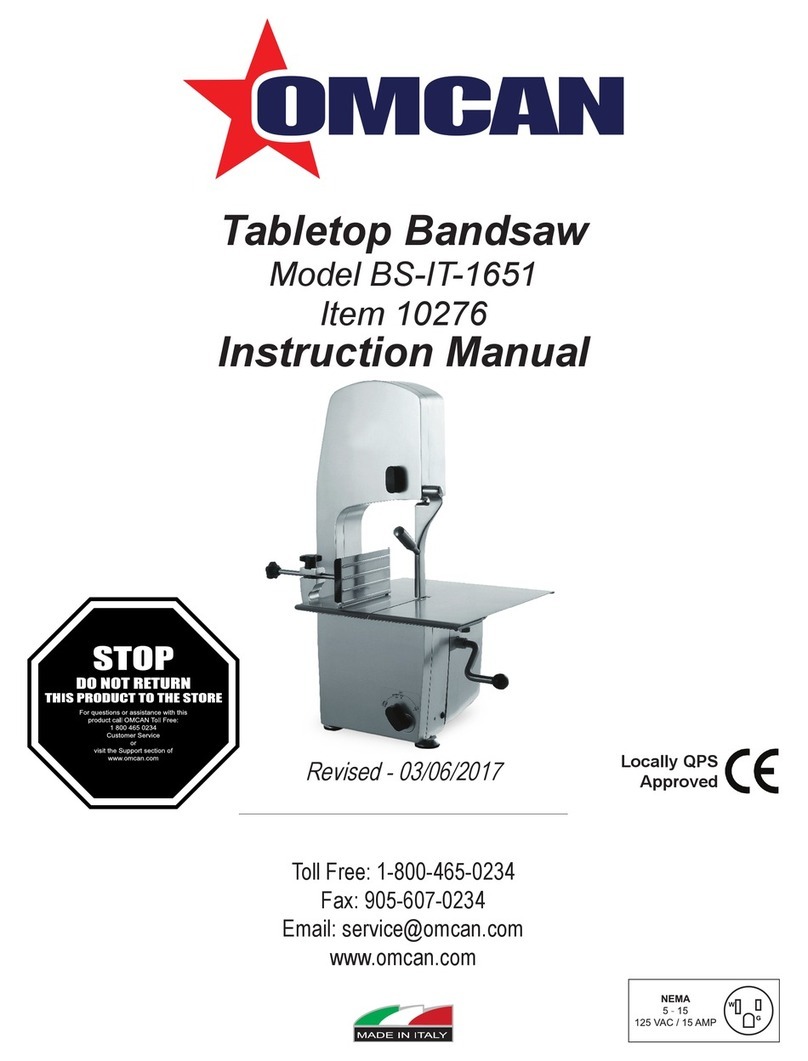
Omcan
Omcan BS-IT-1651 instruction manual

Worcraft PROFESSIONAL
Worcraft PROFESSIONAL RS07-115 instruction manual
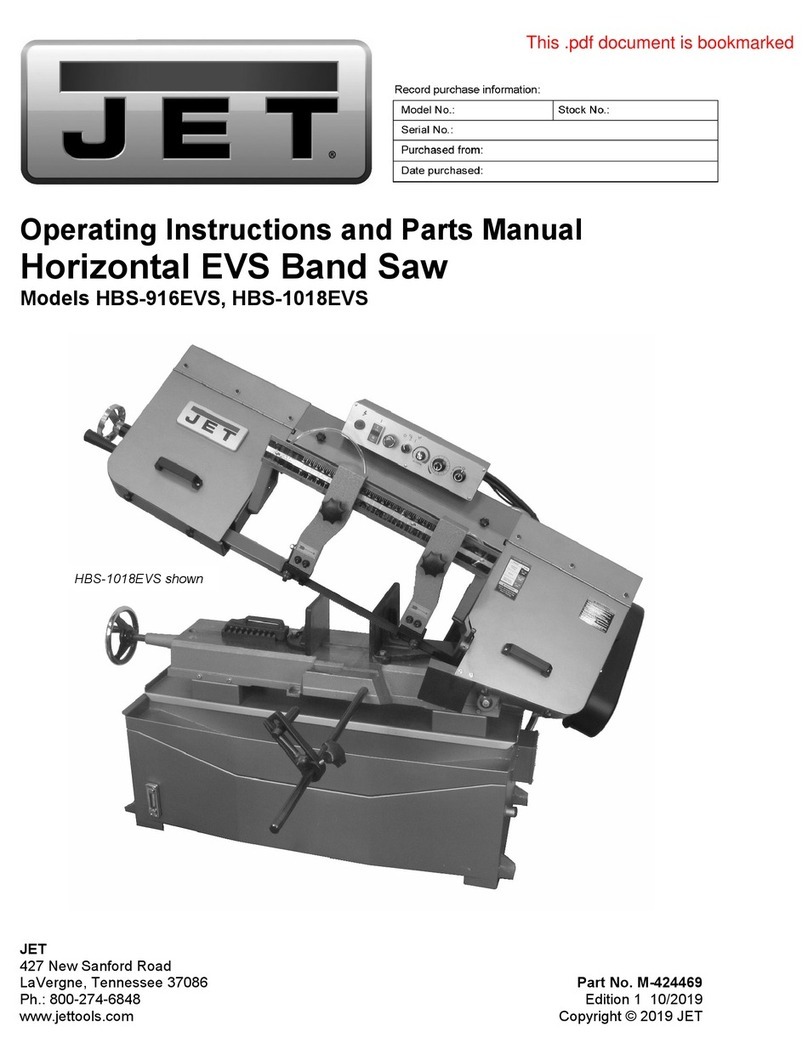
Jet
Jet HBS-916EVS Operating instructions and parts manual
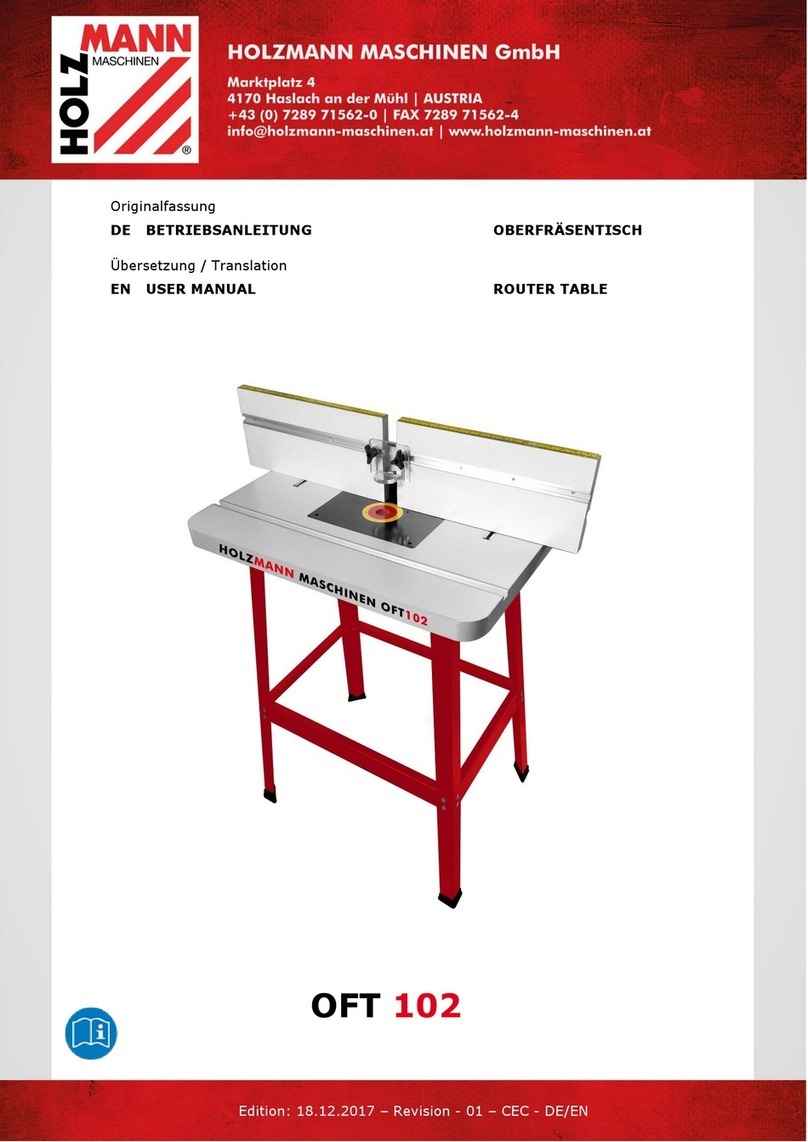
Holzmann
Holzmann OFT 102 user manual

Parkside
Parkside PDS 120 B2 Operating and safety instructions

